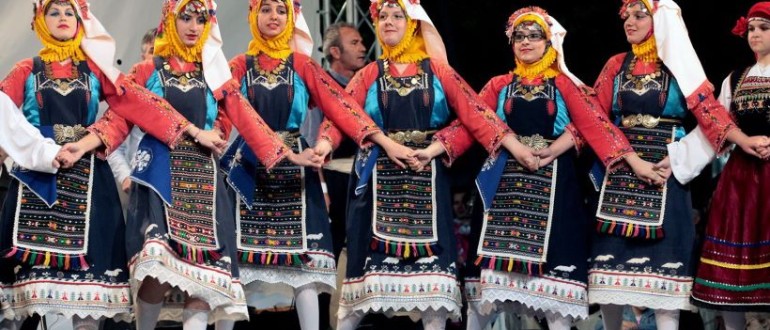Like many other polyphonic traditions of Europe, the Greek tradition of vocal polyphony became known only after the Second World War, during the 1950s. One of the reasons for this could be the fact that Greek music is mostly monophonic. As a matter of fact, together with Romania, Greece could be considered to be one of the most monophonic countries in the Balkans. At the same time, unlike Romania, where the major part of polyphonic tradition seems to be mostly brought there by Macedonian migrants from other parts of the Balkans, Greek polyphonic traditions seem to be an autochthonous survival of the musical culture of the Balkans. style, with a pentatonic structure, involves at least three vocal parts: a melodic line, a fixed drone (ison) sustaining the tonic, and a klostis the song and embroiders the melody with a yodeling voice”. We could add here the predominance of the vertical coordination of the parts on seconds and fourths.
According to the common view of ethnomusicologists, most Greek traditional music is monophonic, both solo and unison. Only in two regions, geographically situated on opposite sides of the country, are vocal forms of traditional polyphony found. These two regions are Epirus (Epir), the Northwestern corner of the country, and the Dodecanese islands (island Rhodes) – the isolated Southeastern island part of the country. Most interestingly, these polyphonic traditions, isolated from each other, retained some important common features.
Mountainous Epirus has traditionally been considered to be the region with the most archaic element of culture and ethnography in Greece, and one of the richest regions in musical traditions. A good description of the three-part polyphonic tradition of Epirus is given in an article by Cowan: “This musical ‘embroiderer”, who alternately leads”.
The similarity between the polyphonic traditions of Epirus with the polyphonic traditions of other regions of the Balkans is quite obvious.
Another polyphonic tradition from Greece (the island Rhodes from the Dodecanese group of islands) also shows the same common features of Balkan polyphony, with the drone, dissonances between the parts, the small range of the main melody, and the pentatonic scale. According to the available information, the tradition of three-part singing with the third part, the yodeling klostis, is not known on Rhodes Island.
The later European style of polyphony became popular on the island of Corfu, where the basis for such influences was created by long-standing political and cultural relationships with Venice (these islands became part of Greece in 1864). According to Cowan, “Romantic serenades (kantadhes), still popular, are the only Greek folk music that uses western harmony: men singing triadic three- and four-part harmonies, accompanying themselves on mandolins and guitars”.
Recently, Greek composer Dionysis Boukouvalas has contacted us and supported our website with the very interesting information about Greek polyphonic culture:
“In the Ionian Islands, Grece, and more particularly in Zakynthos and Kefalonia, there has been developed a homophonic polyphonic traditional style of singing. Notably, this style is almost identical to the Croatian “klapa” singing. Even more, the word “klapa” translates to “company”, a word used in Zakynthos to describe the various traditional singer “companies” (as in companionship). The roots of that style of singing in the Ionian Islands are lost in time, but surely that style was active in the 19th century. This kind of polyphony has the following characteristics: It is 4 part, sung a cappela, by men only, at the town of the two islands (not at the rural places). It is strophic, with solo at the beginning of each verse. This is called “arietta” in Kefalonia (obviously from the Italian word) and Arecchia in Zakynthos (probably from the Italian “a orecchio” = with the ear, because there were no instruments present). Until recently people have treated this kind of polyphony as harmonic, influenced by the West. In a recent publication (in Greek) composer Dionysis Boukouvalas pointed out that in fact the singing in not tonal, but modal, in the Ionian mode. That can be observed in the fact that the harmonic tensions of western harmony are in this style systematically ignored: The subtonic is lowered (instead of raised to the tonic) and the 7th of a seemingly major dominant 7th chord, is raised (instead of lowered to be “resolved”). In fact, Boukouvalas has pointed out that the “chords” created by this polyphonic style are consecutive pitches of the harmonic series. Thus, the 7th of the seemingly “dominant 7th” chord is actually the seventh harmonic of the harmonic series. In other words, this musical style is developed naturally, in the same way that the pentatonic scale is, which also derives directly from the harmonic series”.





